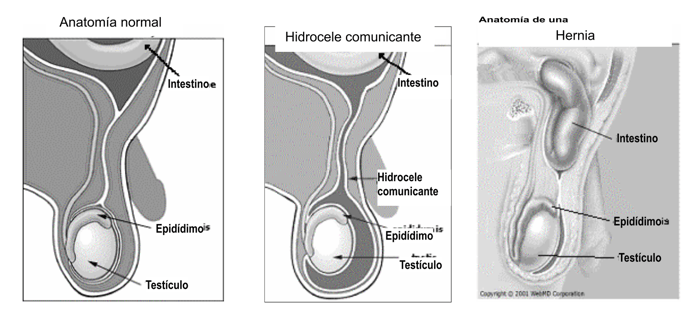Hernias and Hydroceles
What is a hernia or hydrocele?
Swelling of the scrotum or groin area in children is often from a hernia or hydrocele. They can both
be present at the same time.
- A hernia is a large opening in the wall of the abdomen where the intestines go through.
- A hydrocele is a collection of fluid around the testicle. There are 2 types:
– Non-communicating. The connection between the scrotum and abdomen has closed before birth but there is still fluid around the testicle.
– Communicating. The connection between the scrotum and abdomen has not closed and fluid collects around the testicle.

How is it treated?
A non-communicating hydrocele may go away on its own.
Most often a child with communicating hydroceles and a true hernia will need surgery. A small incision is made in the groin. The connection between the scrotum and the abdomen is found and
tied off. If there is a hernia, the intestine is returned to the abdomen. If there is a hydrocele, the fluid is drained.
What happens after surgery?
Diet
The day of his surgery, limit your son’s diet to light foods. The nurse will review this with you before you go home.
Activity
Your child may want to be more active than he should be. The wounds are very fragile and can still be harmed. Limit your child to quiet play for the first 1 to 2 weeks after surgery, this includes no straddle toys or sports. Your child’s surgeon will tell you how long to wait until normal play and activity is allowed.
After surgery continued
Wound
- There will be an incision on the lower abdomen. It is closed with dissolving stitches. These do not have to be removed.
- A firm ridge will develop at the wound site. This will slowly go away. It may take several weeks to months.
- There will be a light dressing over the wound. This may fall off after a few days. If the dressing is still in place after one week, gently take it off.
- Your child may take a shower or sponge bathe the day after surgery and take a bath 1 week after surgery. If stool gets on the wound site, rinse it off with warm water, even within the first
24 hours. Try not to wipe it directly as it will be very tender and fragile. - Bruising and a little swelling are common.
Complications
Complications are unusual but may include:
- Infection or bleeding.
- A hernia or hydrocele that comes back.
- Injury to the blood supply of the testis.
Follow-up
Your doctor will tell you when to follow-up in the clinic. This is normally 2 to 4 weeks after surgery.
Pediatric Urology:
Monday – Friday 8:00am – 4:30 pm
Monday – Friday 4:30pm – 8:00am and weekends
(414) 266-3794
(414) 266-2000 ask for the Urology Resident on call



